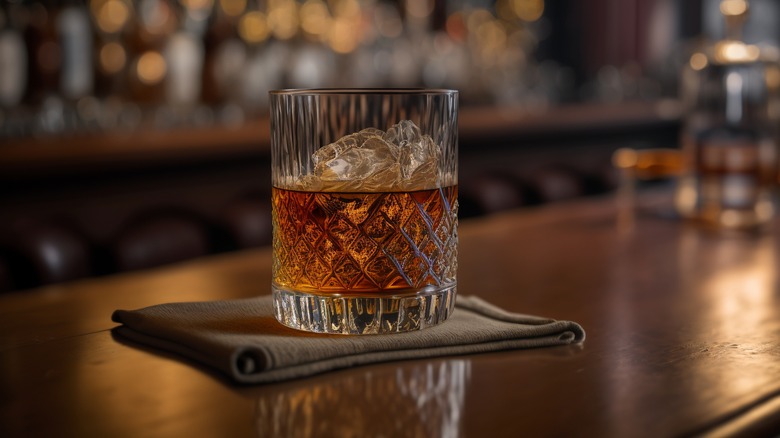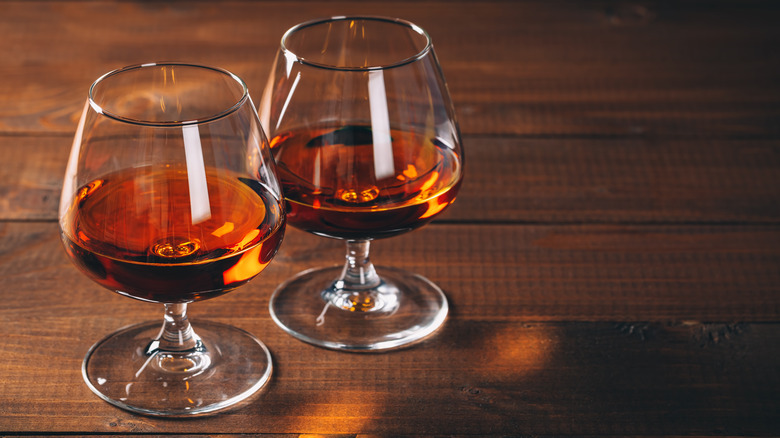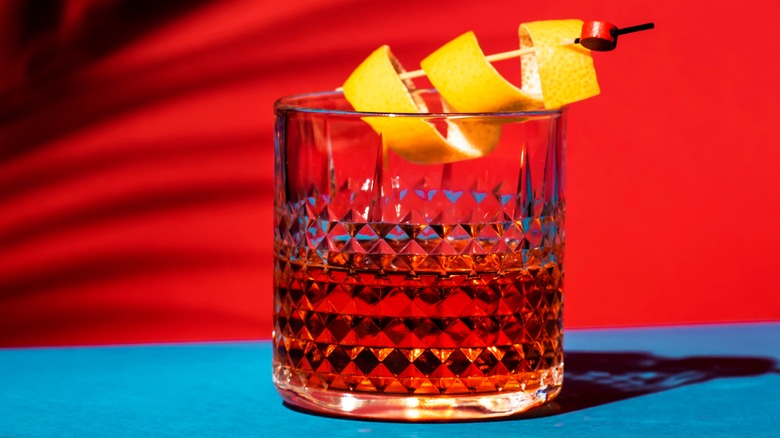The Biggest Difference Between Whiskey And Brandy
At first glance, a glass of whiskey looks awfully similar to brandy. These aged liquors both have a dark brown color and deeply complex flavors that make them go-to choices for classic cocktails, such as the Old Fashioned and sidecar. Both whiskey and brandy also have extensive histories that date back centuries, and it can be quite easy to think that the two are interchangeable, due to their similar "feel."
In reality, these alcohols are very different from each other, mainly due to the ingredients used in the distillation process. There are many key differences between whiskey variants such as bourbon, scotch, and more, but all types of whiskey are distilled from grain — usually barley, but also rye, wheat, and corn. Most whiskeys are described as oaky or woodsy, with hints of rich aromatics such as caramel and citrus.
Brandies, on the other hand, are made from fruits. The process starts with distilling wine, so grapes are the primary source, but other ingredients such as apples and cherries are not uncommon to use. Brandy is usually aged in oak barrels and can carry warm caramel or nutty notes, much like many whiskeys. However, a strong fruity taste sets them apart, and that specific flavor depends heavily on the grape varietals. So don't get it twisted — no matter how much your bottle of Hennessy resembles a dark whiskey, it's a brandy through and through (the brand makes cognac, to be specific).
Production methods also set whiskey and brandy apart
The methods for producing whiskey and brandy aren't super similar, either. To make the former, brewers begin by fermenting a grain mash with yeast. The yeast starts to consume the sugars in the grain mixture, creating an alcoholic "wash" that is then distilled into liquor. The liquid is then treated at least one more time before being aged in wooden barrels. The alcohol transforms from a clear and harsh spirit into a rich, deep brown, warm liquor.
On the other hand, brewers start making brandy by fermenting mashed grapes with yeast. This essentially creates a wine that is then distilled into liquor — but unlike whiskey, standard brandy rarely gets processed more than once. In fact, one of the key differences between cognac and regular brandy is that the former gets treated twice, so if you pick up a non-cognac brandy, a single round of distillation is probably all it's gone through. This isn't to say that standard brandy is inferior, as the countless different varieties have plenty of flavor and complexity to offer.
From there, both whiskey and brandy are stored in wood barrels and aged. The longer these liquors sit in these containers, the mellower their alcoholic "burn" becomes, giving them a smoother mouthfeel. Aging also darkens their color and introduces hints of flavors from the wood caskets they are stored in, giving them more complexity over time.
Whiskeys are more commonly used in mixed drinks
While brandy and whiskey can work in the same types of cocktail recipes, their flavors obviously produce different results. Whiskey is one of the most popular liquors to use in simple mixed drinks. The bourbon smash, Manhattan, and mint julep are just three of the countless cocktails that use whiskey as a leading ingredient. However, many whiskey devotees prefer to enjoy it by itself. It can be served on the rocks or neat without ice, in a short glass tumbler commonly known as a lowball glass.
Brandies, on the other hand, are usually enjoyed neat as a "digestif," or a small chaser served after a meal that is meant to help with digestion. Cognacs like Hennessy are almost exclusively enjoyed in this way, sipped in small quantities in a fancy cup known as a snifter. Some even think that using brandy as a substitute for whiskey in an Old Fashioned is a hot button issue.
Still, there are still plenty of classic mixed drinks based around brandy, such as the metropolitan and sazerac. And if you really love a certain brandy and want to try using it in whiskey-based cocktails, no one can stop you. Breaking the rules and mixing up a rich and fruity Old Fashioned is one way to taste and appreciate the differences between these versatile alcohols.



